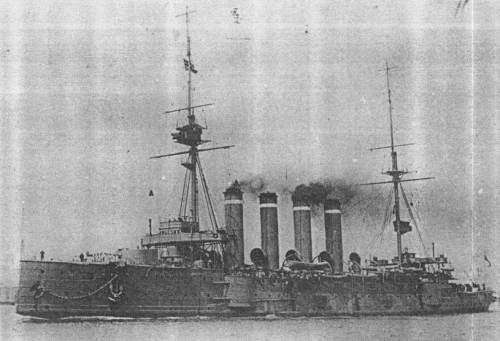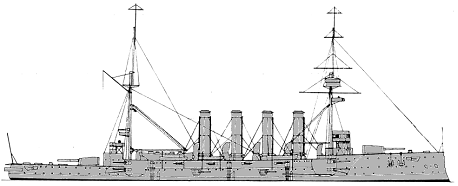
NAVYPEDIA
 Support the project with paypal
Support the project with paypal
Photo

Euryalus 1911
Ships
| Name | No | Yard No | Builder | Laid down | Launched | Comp | Fate |
|---|---|---|---|---|---|---|---|
| Sutlej | N74, N65 | 337 | John Brown, Clydebank | 15.8.1898 | 18.11.1899 | 6.5.1902 | depot ship Crescent II 1.1918 |
| Cressy | N40 | 409 | Fairfield, Govan | 12.10.1898 | 4.12.1899 | 28.5.1901 | sunk 22.9.1914 |
| Aboukir | N00 | 410 | Fairfield, Govan | 9.11.1898 | 16.5.1900 | 3.4.1902 | sunk 22.9.1914 |
| Hogue | N59 | 274 | Vickers, Barrow | 14.7.1898 | 13.8.1900 | 19.11.1902 | sunk 22.9.1914 |
| Bacchante | N39, N09 | 338 | John Brown, Clydebank | 15.2.1899 | 21.2.1901 | 25.11.1902 | sold 7.1920 |
| Euryalus | N51, N44 | 276 | Vickers, Barrow | 18.7.1899 | 20.5.1901 | 5.1.1904 | sold 7.1920 |
Technical data
| Displacement normal, t | 12000 |
|---|---|
| Displacement full, t |
|
| Length, m | 134.1 pp 143.9 oa |
| Breadth, m | 21.2 |
| Draught, m | 7.92 |
| No of shafts | 2 |
| Machinery | 2 4-cyl VTE, 30 Belleville boilers |
| Power, h. p. | 21000 |
| Max speed, kts | 21 |
| Fuel, t | coal 1600 |
| Endurance, nm(kts) | 2610(20) |
| Armour, mm | belt: 152 - 51, bulkheads: 127, decks: 76 - 25, turrets: 152, barbettes: 152, casemates: 127, ammunition tubes: 76, CT: 305 |
| Armament | 2 x 1 - 234/47 BL Mk X, 12 x 1 - 152/45 BL Mk VII, 12 x 1 - 76/40 12pdr 12cwt QF Mk I, 3 x 1 - 47/40 3pdr Hotchkiss Mk I, 2 - 450 TT (sub, beam) |
| Complement | 760 |
Standard scale images

Cressy 1914
Graphics
Project history
Provided under the 1897/98 Programme, these vessels were armoured cruiser versions of the Diadems with more powerful machinery and the the same armament as the Powerful class. The adoption of side armour was made possible by the development of hard faced steel armour which allowed for a comparatively large area of the side to be protected without an excessive increase in displacement. The 234mm turrets were hydraulically powered and the guns could be loaded at any angle of training or elevation; the hoists were electrically powered. The class was 1000t larger than the Diadems and had a fuller hull form which improved stability, but the ships had finer lines forward which increased their pitching motion. On trials all exceeded the designed speed except Cressy (20.7kts), the best being Hague which made 22.06kts with 21432ihp. The completion of Euryalus was delayed by a series of accidents and she was two years late in entering service.
Ship protection
The main 152mm Krupp steel belt was 70.4m long by 0.5m deep extending from the main deck to 1.5m below the waterline. It was closed at the ends by 127mm bulkheads and extended to the bow by 51mm armour. The protective deck was correspondingly reduced in thickness to 38mm but increased to 64mm abaft the belt and to 76mm over the steering gear, the main deck from the after bulkhead to the stem being 25mm thick. Armoured tubes were provided to protect the ammunition hoists to the 234mm guns but these were not fitted for the casemate guns as the hoists were behind the side armour.
Modernizations
None.
Naval service
Cressy, Aboukir and Hogue were torpedoed and sunk by German submarine U9 22.9.1914 off Hoek van Holland in North Sea.
Bacchante was damaged in collision with cruiser Achilles in the Irish Sea in February 1917. Sutlej served as Boys` TS in 1906-1909. She was renamed Crescent II as depot ship in January 1918 (she had been laid up there as an accommodation ship in 1917), reverted to Sutlej in 1919 before being put on sale list.
Many thanks to Wolfgang Stöhr for additional information on this page.
 HOME
HOME FIGHTING SHIPS OF THE WORLD
FIGHTING SHIPS OF THE WORLD UNITED KINGDOM
UNITED KINGDOM CRUISERS
CRUISERS CRESSY 1 class armoured cruisers (6, 1901 - 1904)
CRESSY 1 class armoured cruisers (6, 1901 - 1904)
